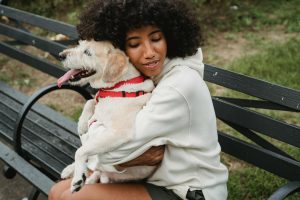Does your dog bark, lunge, or growl at other dogs? What happens when you are out for a walk? Puppy aggression can be a problem if you do not react on time. It is one of the main reasons dog owners look for a professional dog trainer for help. But do not freak out at every barking.
Today, we will talk about the difference between puppy aggression and play aggression. Reactive behavior can lead to aggressive behavior and aggressive interaction. But we know that puppies love to play, and sometimes, when they play, they bark and bite each other.
It is important to understand that your dog might play, yet still, show aggressive behavior. Learn how to recognize it and prevent it from becoming a bigger problem.
Understanding Body Language
First, we need to start with understanding the overall body posture and body movement of your dog. And with that in mind, let’s start from the beginning.
Dogs show facial and body movements to initiate play. Sometimes, barking and growling are involved. But there is a difference between a barking dog or play and a dog barking because of aggression.
Playful dog has a body movement that is loose and wiggly. There is lots of movement and brief pauses during play.
On the other hand, an aggressive dog seems stiff, moves slowly, or keeps moving away from the other dog. These are social signs and social interactions that show your dog is not interested in play.
How to recognize the play session is over? That is when your dog looks away, sniffs, scratches, or lies down.
Then there is the fearful dog. This young puppy will lean away, lean back, tremble, crouch, or lower his body and roll into his side or back. Do not force or push your dog to play if he is not interested. With that in mind, an extremely fearful dog might even freeze completely or try to escape the play session. Fear aggression is a real thing, and you should be aware of it.
Dogs that display aggressive behavior look large, stand with their head raised above their shoulders, and their overall body language is tense.
And if you want a better sign, during play aggression, dogs growl and bare their teeth during a game. It might look scary from a far, but it is actually how they play. In puppy aggression, there is no play and you need to manage it. In play aggression, your dog‘s behavior is triggered by the excitement of the game and the movement of the person, dog, or toy involved in the game.
Managing puppy play aggression
We said before that play aggression is normal puppy behavior. Dogs use it when playing with each other. They also use it when playing with a chew toy or with their human. For example, Milo loves nipping when we play.
But it is crucial that you manage play aggression. Otherwise, it might lead to puppy aggression and aggressive behavior towards other dogs. If your young puppy bites too hard, the other dog will not want to play. And it might result in a conflict.
The best way to manage dog aggression is by teaching your dog bite inhibition. I’ve written an article about it before.
But let’s go over the basic premises again. The trick is to show your puppy the level of the bite he can use. Simply said, if your aggressive puppy bites too hard while playing, stop the game and walk away. Then, resume playing, hoping your dog bites gentler.
Always aim for a below threshold biting. This way, your puppy will bite during play, but it will never cause an injury or problem to the other dog.
You can stimulate play in a controlled environment at home. You can play either with a toy or by using your hands. Most importantly, teach your puppy to stop biting on command.
How to Reduce the Risk of Aggressive Dog
Let’s finish off the article by talking about how to reduce the risk of your dog becoming aggressive. First and foremost, we have to mention that PUNISHMENT METHODS HAVE WORSEN AGGRESSION. That is why you should never use punishment. There are other ways to change canine behavior or discipline your aggressive puppy.
I firmly believe in positive reinforcement dog training. That means do not punish your dog. Instead, revert canine behavior to something else. Here are some ways to reduce the risk of an aggressive dog.
Distract from bad behavior
This is the most common technique I use it to correct a dog behavior. You can do it by carrying a toy your dog loves. Transfer his attention to the chew toy, and your puppy will play with you instead of barking and howling at other dogs.
Praise calm behavior
You should never ignore good behavior. If your dog is calm around dogs, praise it and give treats. Reward behavior you want your puppy to exhibit.
Socialize your puppy
Let’s be honest about something. Your dog might not like all dogs. It is just not normal. We do not love all people right? But socialization can help your puppy act normal around other dogs.
However, when you socialize your dog, be careful not to socialize it with reactive dogs, unfamiliar dogs, and puppies exhibiting aggressive tendencies.
Schedule play-in sessions with dog owners in your area that have a well-behaved puppy.
Provide mental stimulation
An exhausted puppy is a happy puppy. That is a rule I like to live by. What does it mean? Well, besides physical exercise, you should provide mental stimulation for your pup as well. This means lots of toys like Kong, puzzle toys, and learning tricks and commands with your puppy.








